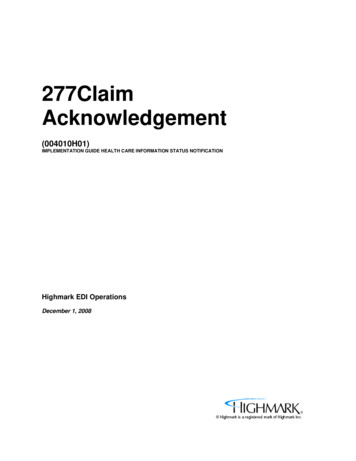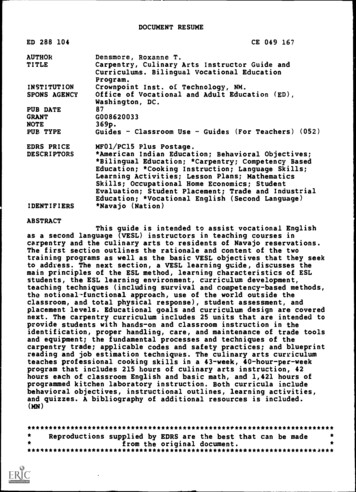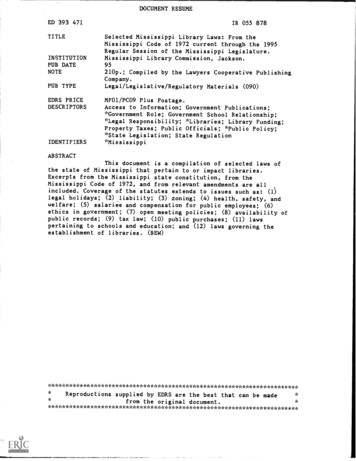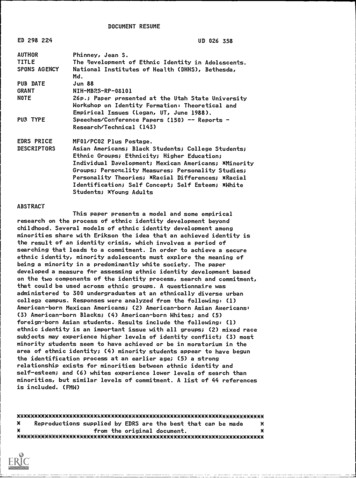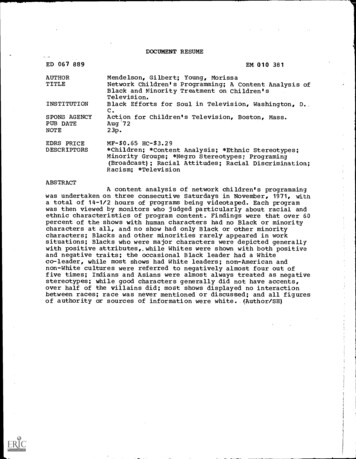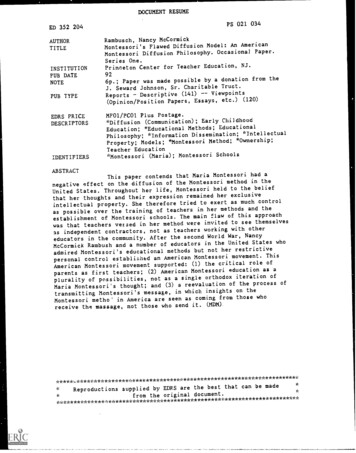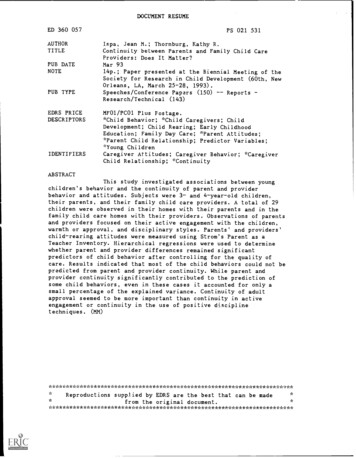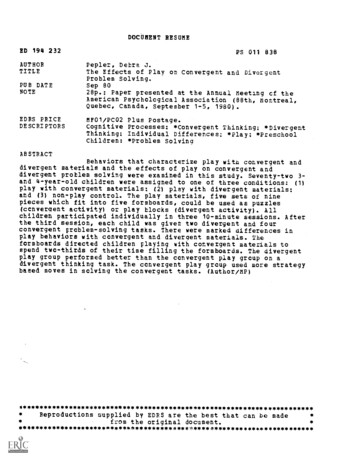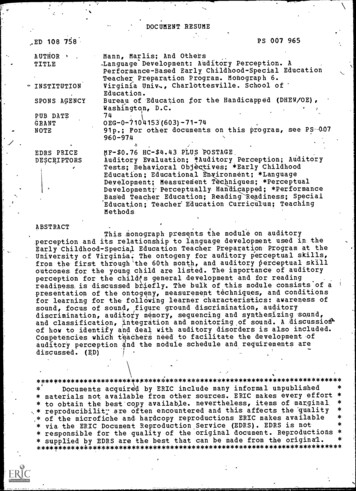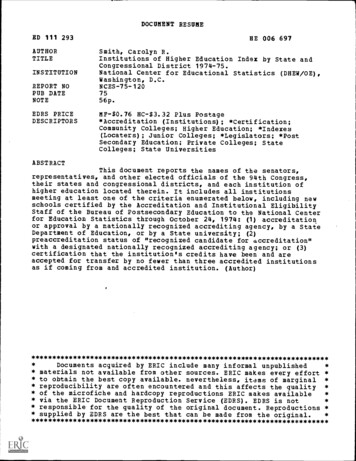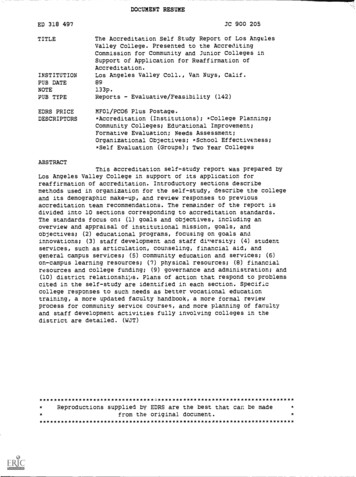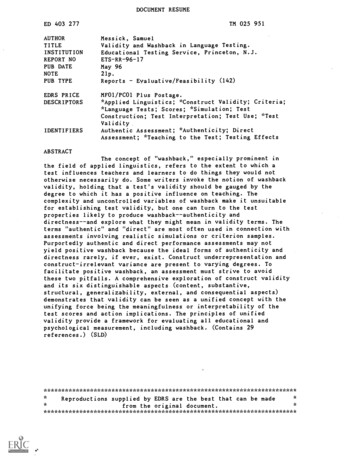
Transcription
DOCUMENT RESUMETM 025 951ED 403 277AUTHORTITLEINSTITUTIONREPORT NOPUB DATENOTEPUB TYPEMessick, SamuelValidity and Washback in Language Testing.Educational Testing Service, Princeton, N.J.ETS-RR-96-17May 96EDRS PRICEDESCRIPTORSMFO1 /PCO1 Plus ty (142)*Applied Linguistics; *Construct Validity; Criteria;*Language Tests; Scores; *Simulation; TestConstruction; Test Interpretation; Test Use; *TestValidityAuthentic Assessment; *Authenticity; DirectAssessment; *Teaching to the Test; Testing EffectsABSTRACTThe concept of "washback," especially prominent inthe field of applied linguistics, refers to the extent to which atest influences teachers and learners to do things they would nototherwise necessarily do. Some writers invoke the notion of washbackvalidity, holding that a test's validity should be gauged by thedegree to which it has a positive influence on teaching. Thecomplexity and uncontrolled variables of washback make it unsuitablefor establishing test validity, but one can turn to the testproperties likely to produce washback--authenticity anddirectness--and explore what they might mean in validity terms. Theterms "authentic" and "direct" are most often used in connection withassessments involving realistic simulations or criterion samples.Purportedly authentic and direct performance assessments may notyield positive washback because the ideal forms of authenticity anddirectness rarely, if ever, exist. Construct underrepresentation andconstruct-irrelevant variance are present to varying degrees. Tofacilitate positive washback, an assessment must strive to avoidthese two pitfalls. A comprehensive exploration of construct validityand its six distinguishable aspects (content, substantive,structural, generalizability, external, and consequential aspects)demonstrates that validity can be seen as a unified concept with theunifying force being the meaningfulness or interpretability of thetest scores and action implications. The principles of unifiedvalidity provide a framework for evaluating all educational andpsychological measurement, including washback. (Contains 29references.) (SLD)**************** ** * ****,'c* **** * ** ****** ** * **** 'c*** ******** ** * ***** *** * **Reproductions supplied by EDRS are the best that can be madefrom the original ******************************
RR-96-17U.S. DEPARTMENT OF EDUCATIONand ImprovementEDU TIONAL RESOURCES INFORMATIONCENTER (ERIC)This document has been reproduced asreceived from the person or organizationoriginating it.Minor changes have been made toimprove reproduction quality.1Office of Educational ResearchESEPERMISSION TO REPRODUCE ANDDISSEMINATE THIS MATERIALHAS BEEN GRANTED BYJAYl saet9UAjTO THE EDUCATIONAL RESOURCESINFORMATION CENTER (ERIC)slated in thisPoints of view or opinionsdocument do not necessarily representofficial OERI position or policy.ARC REVALIDITY AND WASHBACKIN LANGUAGE TESTINGORSamuel MessickTEducational Testing ServicePrinceton, New JerseyMay 19962BEST COM/AVAILABLE
Copyright 1996. Educational Testing Service. All rights reserved.3
VALIDITY AND WASHBACK IN LANGUAGE TESTINGSamuel MessicklEducational Testing ServiceThe current educational reform movement in the United States putsconsiderable stock in the notion that performance assessments, as opposed tomultiple-choice tests, will facilitate improved teaching and learning (Resnick& Resnick, 1991; Wiggins, 1989, 1993).Some proponents even claim thatperformance assessments, especially those that are authentic and direct, arelikely to be "systemically valid" in that they induce "in the education systemcurricular and instructional changes that foster the development of thecognitive skills that the test is designed to measure" (Frederiksen & Collins,1989, p. 27).A kindred notion prominent in applied linguistics, especially inBritain, is called "washback," which is the extent to which the testinfluences language teachers and learners to do things they would nototherwise necessarily do (Alderson & Wall, 1993).As with so-called systemicvalidity, some writers invoke the notion of "washback validity," holding thata test's validity should be gauged by the degree to which it has a positiveinfluence on teaching (Morrow, 1986).In the assessment of skills, tests having beneficial washback are likelyto be criterion samples.That is, in the case of language testing, theassessment should include authentic and direct samples of the communicativebehaviors of listening, speaking, reading, and writing of the language beinglearned.Ideally, the move from learning exercises to test exercises shouldbe seamless.As a consequence, for optimal positive washback there should belittle if any difference between activities involved in learning the languageand activities involved in preparing for the test.Although only sparsely investigated to date, evidence of washback istypically sought in terms of behavioral and attitudinal changes in teachersand learners that are associated with the introduction of tests having1For their stimulating and helpful comments on the manuscript, gratefulacknowledgements are extended to Charles Alderson, Gary Buck, Gordon Hale,Ann Jungeblut, and Dianne Wall.
- 2 -important educational consequences (Alderson & Wall, 1993).With respect toU.S. education reform, a more stringent claim has been made involving not onlychanges in teacher and learner behaviors but also in learner outcomes.Towit, "evidence for systemic validity would be an improvement in [the tested]skills after the test has been in place within the educational system for aperiod of time" (Frederiksen & Collins, 1989, p. 27).However, such forms of evidence are only circumstantial with respect totest validity in that a poor test may be associated with positive effects anda good test with negative effects because of other things that are done or notdone in the educational system.Technically speaking, such effects should notbe viewed as test washback but rather as due to good or bad educationalpractices apart from the quality of the test.Furthermore, a test mightinfluence what is taught but not how it is taught, might influence teacherbehaviors but not learner behaviors, or might influence both with little or noimprovement in skills.Hence, washback is a consequence of testing that bearson validity only if it can be evidentially shown to be an effect of the testand not of other forces operative on the educational scene.Indeed, if itexists, washback "is likely to be a complex phenomenon which cannot be relateddirectly to a test's validity" (Alderson & Wall, 1993, p. 116).In any event,washback is only one form of testing consequence that needs to be weighed inevaluating validity, and testing consequences are only one aspect of constructvalidity needing to be addressed.Neither testing consequences in general norwashback in particular can stand alone as a standard of validity.Hence, one should not rely on washback, with all its complexity anduncontrolled variables, to establish test validity, Morrow (1986) andFrederiksen and Collins (1989) notwithstanding.Rather, one can instead turnto the test properties likely to produce washback -- namely, authenticity anddirectness -- and ask what they might mean in validity terms.Next, weexamine the implications of authenticity and directness for test validity andthen cast the issues in the broader context of a comprehensive view ofconstruct validity.The broader concept is emphasized for two main reasons.First, in thisvalidity framework, washback is seen as an instance of the consequentialaspect of construct validity, which, along with five other important aspects,
- 3 -address the key questions that need to be answered in evaluating testvalidity.Second, by focussing not on washback per se but on the deeper andmore encompassing issue of validity, we highlight the multiple forms ofevidence needed to sustain valid language test use.In particular, byattempting to minimize sources of invalidity in language test design, the testdeficiencies and contaminants that stimulate negative washback are alsominimized, thereby increasing the likelihood of positive washback.In short, we emphasize first the need to establish valid evidentialgrounds for trustworthy inferences about tested language proficiency toprovide a basis for distinguishing test-linked positive washback from goodteaching regardless of the quality of the test and negative washback from poorteaching.This is important because, technically speaking, evidence ofteaching and learning effects should be interpreted as washback -- either ingeneral or in particular as contributing to the consequential aspect ofconstruct validity -- only if that evidence can be linked to the introductionand use of the test.AUTHENTICITY AND DIRECTNESS AS VALIDITY STANDARDSThe two terms "authentic" and "direct" are most often used in connectionwith assessments involving realistic simulations or criterion samples.Because it is widely thought in some educational circles that authenticity anddirectness of assessment facilitate positive consequences for teaching andlearning (e.g., Resnick & Resnick, 1991; Wiggins, 1993), they constitute tacitvalidity standards, so we need to address what these labels might mean invalidity terms.Minimizing Sources of InvalidityIdeally, authentic assessments pose engaging and worthy tasks (usuallyinvolving multiple processes) in realistic settings or close simulations sothat the tasks and processes, as well as available time and resources,parallel those in the real world.The major measurement concern ofauthenticity is that nothing important be left out of the assessment of thefocal construct (Messick, 1994).This is tantamount to the general validity6
- 4 -standard of minimal construct underrepresentation.However, althoughauthenticity implies minimal construct underrepresentation, the obverse doesnot hold.This is the case because minimal construct underrepresentation doesnot necessarily imply the close simulation of real-world processes andresources typically associated with authenticity in the current educationalliterature on performance assessment.Ideally, direct assessments involve open-ended tasks in which therespondent can freely perform the complex skill at issue unfettered bystructured item forms or restrictive response formats.The intent is tominimize constraints on examinee behavior associated with sources ofconstruct-irrelevant method variance such as testwiseness in coping withvarious item-types, differential tendencies toward guessing, and otherartificial restrictions on examinees' representations of problems and on theirmodes of thinking or response.Thus, the major measurement concern ofdirectness is that nothing irrelevant be added that interferes with orcontaminates construct assessment.This is tantamount to the general validitystandard of minimal construct-irrelevant variance (Messick, 1994).Incidentally, the term "direct assessment" is a misnomer because it alwayspromises too much.In education and psychology, "all measurements areindirect in one sense or another" (Guilford, 1936, p. 5).Measurement alwaysinvolves, even if only tacitly, intervening processes of judgment, comparison,or inference.In the threat to validity known as construct underrepresentation (whichjeopardizes authenticity), the assessment is deficient:The test is toonarrow and fails to include important dimensions or facets of focalconstructs.In the threat to validity known as construct-irrelevant variance(which jeopardizes directness), the assessment is too broad, containing excessreliable variance that is irrelevant to the interpreted construct.threats are operative in all assessments.BothHowever, as always in testvalidation, the critical issue is the gathering of sufficiently compellingevidence to counter these two major threats to construct validity.A comprehensive unified view of construct validity will be consideredshortly as a means of addressing an interrelated set of perennial validityquestions.But first let us briefly examine the widely anticipated connection7
- 5 -of authentic and direct assessments with washback, a link that Alderson andWall (1990) maintain is still evidentially tenuous at best.Facilitating Positive flashbackThere are a number of reasons why purportedly authentic and directperformance assessments do not readily yield positive washback.Some reasonspertain to properties of the assessment itself and others to properties of theeducational system, especially of the instructional and assessment setting.To begin with, the ideal forms of authenticity and directness rarely ifever exist.To some degree, construct underrepresentation and construct-irrelevant variance are ever with us.exemplar of criterion behaviors.The test is never a completely faithfulThis is so for at least two reasons.First,by its very nature, the test is likely to evoke evaluative anxiety andattendant coping processes that are not operative in the criterionperformance, at least not in the same way (Loevinger, 1957).Second, the testperformances are scored and interpreted in ways that are unlikely to fully orfaithfully capture the criterion domain processes.In language testing, as inall educational and psychological measurement, what matters are not theprocesses operative in task performance, exemplary though they may be, but theprocesses captured in test scoring and interpretation.If it occurs, washbackis likely to be oriented toward the achievement of high test scores as opposedto the attainment of facile domain skills.Thus, to facilitate positivewashback, the assessment must strive to minimize construct underrepresentationand construct-irrelevant difficulty in the interpreted scores.With respect to the instructional and assessment setting, there are anumber of links in the chain that ostensibly binds the test to positivewashback, and these links need to be more strongly forged than is ordinarilythe case.Specifically, for performance assessments to "fulfill their promiseof driving improvements in student learning and achievement, assessmentsystems must incorporate the means for affecting what teachers do and how theythink about what they do in their classrooms" (Sheingold, Heller, &Paulukonis, 1995).For example, in one effort to achieve systemic validity orpositive washback, the assessment system involved teachers responsible fordefining, creating, and revising the assessment tasks, with the aid ofcognitive supports in the form of guiding questions and design guidelines as
-6 well as the social support of the teachers working collaboratively amongthemselves and with outside experts.Thus, washback appears to depend on anumber of important factors in the educational system in addition to thevalidity of the tests.We turn now to a comprehensive view of construct validity as a means ofintegrating complementary forms of evidence pertinent to validity, includingevidence of washback.COMPREHENSIVENESS OF CONSTRUCT VALIDITYValidity is an overall evaluative judgment of the degree to whichempirical evidence and theoretical rationales support the adequacy andappropriateness of interpretations and actions based on test scores or othermodes of assessment (Messick, 1989).Validity is not a property of the testor assessment as such, but rather of the meaning of the test scores.Hence,what is to be validated is not the test or observation device per se butrather the inferences derived from test scores or other indicators (Cronbach,1971) -- inferences about score meaning or interpretation and about theimplications for action that the interpretation entails.For example, a validated proficiency test can be subverted by coaching,or test preparation practices emphasizing testwiseness strategies, that mightincrease test scores without correspondingly improving the skills measured bythe test.Although this would not compromise the validity of the uncoachedtest in general, the validity of the interpretation and use of the coachedscores would be jeopardized.In contrast, test preparation practicesemphasizing test familiarization and anxiety reduction may actually improvevalidity:Scores that formerly were invalidly low because of anxiety mightnow become validly higher (Messick, 1982).In essence, then, test validation is empirical evaluation of the meaningand consequences of measurement, taking into account extraneous factors in theapplied setting that might erode or promote the validity of local scoreinterpretation and use.Because score meaning is a construction that makestheoretical sense out of both the performance regularities summarized by thescore and its pattern of relationships with other variables, the psychometricliterature views the fundamental issue as construct validity.
- 7Perennial Validity QuestionsTo evaluate the meaning and consequences of measurement is no smallorder, however, and requires attention to a number of persistent validityquestions, such as:Are we looking at the right things in the right balance?Has anything important been left out?Does our way of looking introduce sources of invalidity orirrelevant variance that bias the scores or judgments?Does our way of scoring reflect the manner in which domainprocesses combine to produce effects and is our score structureconsistent with the structure of the domain about which inferencesare to be drawn or predictions made?What evidence is there that our scores mean what we interpret themto mean, in particular, as reflections of personal attributes orcompetencies having plausible implications for educational action?Are there plausible rival interpretations of score meaning oralternative implications for action and, if so, by what evidenceand arguments are they discounted?Are the judgments or scores reliable and are their properties andrelationships generalizable across the contents and contexts ofuse as well as across pertinent population groups?Are the value implications of score interpretations empiricallygrounded, especially if pejorative in tone, and are theycommensurate with the score's trait implications?Do the scores have utility for the proposed purposes in theapplied settings?Are the scores applied fairly for these purposes, that is,consistently and equitably across individuals and groups?Are the short- and long-term consequences of score interpretationand use supportive of the general testing aims and are there anyadverse side-effects?Which, if any, of these questions is unnecessary to address injustifying score interpretation and use?Which, if any, can be forgone invalidating the interpretation and use of performance assessments or othermodes of assessment?The general thrust of such questions is to seek evidence10
- 8and arguments to discount the two major threats to construct validity -namely, construct underrepresentation and construct-irrelevant variance -- aswell as to evaluate the action implications of score meaning.Addressing these questions with solid evidence is important both ingeneral to justify test use and in particular in connection with the currentemphasis on washback.For example, attempting to improve validity by testdesign, as is implied by many of these questions, may increase the likelihoodof positive washback.In turn, evidence of washback contributes to theconsequential aspect of construct validity.Furthermore, information aboutthe operative level of test validity should help one distinguish test washbackper se from the effects of good or bad educational practices regardless of thequality of the test.With regard to the latter point, if a test's validity is compromisedbecause of construct underrepresentation or construct-irrelevant variance, itis likely that any signs of good teaching or learning associated with the useof the test are only circumstantial and more likely due to good educationalpractices regardless of test use.Similarly, signs of poor teaching orlearning associated with th
DOCUMENT RESUME ED 403 277 TM 025 951 AUTHOR Messick, Samuel TITLE Validity and Washback in Language Testing.
